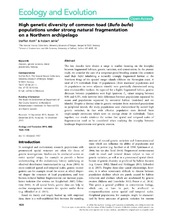High genetic diversity of common toad (Bufo bufo) populations under strong natural fragmentation on a Northern archipelago
Peer reviewed, Journal article
Published version

Åpne
Permanent lenke
https://hdl.handle.net/1956/15247Utgivelsesdato
2016-03Metadata
Vis full innførselSamlinger
Originalversjon
https://doi.org/10.1002/ece3.1957Sammendrag
The last decades have shown a surge in studies focusing on the interplay between fragmented habitats, genetic variation, and conservation. In the present study, we consider the case of a temperate pond-breeding anuran (the common toad Bufo bufo) inhabiting a naturally strongly fragmented habitat at the Northern fringe of the species’ range: islands offshore the Norwegian coast. A total of 475 individuals from 19 populations (three mainland populations and 16 populations on seven adjacent islands) were genetically characterized using nine microsatellite markers. As expected for a highly fragmented habitat, genetic distances between populations were high (pairwise Fst values ranging between 0.06 and 0.33), with however little differences between populations separated by ocean and populations separated by terrestrial habitat (mainland and on islands). Despite a distinct cline in genetic variation from mainland populations to peripheral islands, the study populations were characterized by overall high genetic variation, in line with effective population sizes derived from single-sample estimators which were on average about 20 individuals. Taken together, our results reinforce the notion that spatial and temporal scales of fragmentation need to be considered when studying the interplay between landscape fragmentation and genetic erosion.
